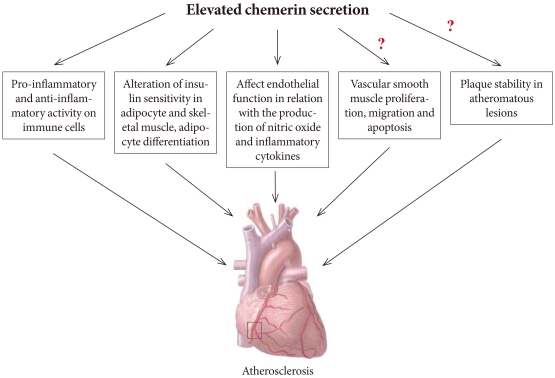
- Current
- Browse
- Collections
-
For contributors
- For Authors
- Instructions to authors
- Article processing charge
- e-submission
- For Reviewers
- Instructions for reviewers
- How to become a reviewer
- Best reviewers
- For Readers
- Readership
- Subscription
- Permission guidelines
- About
- Editorial policy
Articles
- Page Path
- HOME > Diabetes Metab J > Volume 35(3); 2011 > Article
-
EditorialChemerin: A Novel Link between Inflammation and Atherosclerosis?
- Eun-Jung Rhee
-
Diabetes & Metabolism Journal 2011;35(3):216-218.
DOI: https://doi.org/10.4093/dmj.2011.35.3.216
Published online: June 30, 2011
Department of Endocrinology and Metabolism, Kangbuk Samsung Hospital, Sungkyunkwan University School of Medicine, Seoul, Korea.
- Corresponding author: Eun-Jung Rhee. Department of Endocrinology and Metabolism, Kangbuk Samsung Hospital, Sungkyunkwan University School of Medicine, 108 Pyeong-dong, Jongno-gu, Seoul 110-746, Korea. hongsiri@hanmail.net
Copyright © 2011 Korean Diabetes Association
This is an Open Access article distributed under the terms of the Creative Commons Attribution Non-Commercial License (http://creativecommons.org/licenses/by-nc/3.0/) which permits unrestricted non-commercial use, distribution, and reproduction in any medium, provided the original work is properly cited.
- 1. Libby P. Inflammation in atherosclerosis. Nature 2002;420:868-874. ArticlePubMedPDF
- 2. Ernst MC, Sinal CJ. Chemerin: at the crossroads of inflammation and obesity. Trends Endocrinol Metab 2010;21:660-667. ArticlePubMed
- 3. Wittamer V, Franssen JD, Vulcano M, Mirjolet JF, Le Poul E, Migeotte I, Brezillon S, Tyldesley R, Blanpain C, Detheux M, Mantovani A, Sozzani S, Vassart G, Parmentier M, Communi D. Specific recruitment of antigen-presenting cells by chemerin, a novel processed ligand from human inflammatory fluids. J Exp Med 2003;198:977-985. ArticlePubMedPMCPDF
- 4. Wittamer V, Bondue B, Guillabert A, Vassart G, Parmentier M, Communi D. Neutrophil-mediated maturation of chemerin: a link between innate and adaptive immunity. J Immunol 2005;175:487-493. ArticlePubMedPDF
- 5. Meder W, Wendland M, Busmann A, Kutzleb C, Spodsberg N, John H, Richter R, Schleuder D, Meyer M, Forssmann WG. Characterization of human circulating TIG2 as a ligand for the orphan receptor ChemR23. FEBS Lett 2003;555:495-499. ArticlePubMedPDF
- 6. Roh SG, Song SH, Choi KC, Katoh K, Wittamer V, Parmentier M, Sasaki S. Chemerin--a new adipokine that modulates adipogenesis via its own receptor. Biochem Biophys Res Commun 2007;362:1013-1018. ArticlePubMed
- 7. Takahashi M, Takahashi Y, Takahashi K, Zolotaryov FN, Hong KS, Kitazawa R, Iida K, Okimura Y, Kaji H, Kitazawa S, Kasuga M, Chihara K. Chemerin enhances insulin signaling and potentiates insulin-stimulated glucose uptake in 3T3-L1 adipocytes. FEBS Lett 2008;582:573-578. ArticlePubMed
- 8. Becker M, Rabe K, Lebherz C, Zugwurst J, Goke B, Parhofer KG, Lehrke M, Broedl UC. Expression of human chemerin induces insulin resistance in the skeletal muscle but does not affect weight, lipid levels, and atherosclerosis in LDL receptor knockout mice on high-fat diet. Diabetes 2010;59:2898-2903. ArticlePubMedPMCPDF
- 9. Lehrke M, Becker A, Greif M, Stark R, Laubender RP, von Ziegler F, Lebherz C, Tittus J, Reiser M, Becker C, Goke B, Leber AW, Parhofer KG, Broedl UC. Chemerin is associated with markers of inflammation and components of the metabolic syndrome but does not predict coronary atherosclerosis. Eur J Endocrinol 2009;161:339-344. ArticlePubMed
- 10. Bozaoglu K, Bolton K, McMillan J, Zimmet P, Jowett J, Collier G, Walder K, Segal D. Chemerin is a novel adipokine associated with obesity and metabolic syndrome. Endocrinology 2007;148:4687-4694. ArticlePubMedPDF
- 11. Kaur J, Adya R, Tan BK, Chen J, Randeva HS. Identification of chemerin receptor (ChemR23) in human endothelial cells: chemerin-induced endothelial angiogenesis. Biochem Biophys Res Commun 2010;391:1762-1768. ArticlePubMed
- 12. Muruganandan S, Parlee SD, Rourke JL, Ernst MC, Goralski KB, Sinal CJ. Chemerin, a novel PPAR{gamma} target gene that promotes mesenchymal stem cell adipogenesis. J Biol Chem Epub 2011 May 14. DOI: 10.1074/jbc.M111.220491.
- 13. Spiroglou SG, Kostopoulos CG, Varakis JN, Papadaki HH. Adipokines in periaortic and epicardial adipose tissue: differential expression and relation to atherosclerosis. J Atheroscler Thromb 2010;17:115-130. ArticlePubMed
- 14. Yamawaki H. Vascular effects of novel adipocytokines: focus on vascular contractility and inflammatory responses. Biol Pharm Bull 2011;34:307-310. ArticlePubMed
- 15. Hah YJ, Kim NK, Kim MK, Kim HS, Yoon HJ, Hur SH, Kim YN, Park KG. Relationship between chemerin levels and cardiometabolic parameters and degree of coronary stenosis in Korean patients with coronary artery disease. Diabetes Metab J 2011;35:248-254.ArticlePubMedPMC
REFERENCES
Figure & Data
References
Citations
Citations to this article as recorded by 

- Nutritional Status and Selected Adipokines in Children with Irritable Bowel Syndrome
Wojciech Roczniak, Agnieszka Szymlak, Bogdan Mazur, Agata Chobot, Małgorzata Stojewska, Joanna Oświęcimska
Nutrients.2022; 14(24): 5282. CrossRef - Chemerin regulates formation and function of brown adipose tissue: Ablation results in increased insulin resistance with high fat challenge and aging
Yiqiang Zhang, Wen‐Jun Shen, Shuo Qiu, Pinglin Yang, Garrett Dempsey, Lei Zhao, Qin Zhou, Xiao Hao, Dachuan Dong, Andreas Stahl, Fredric B. Kraemer, Lawrence L. Leung, John Morser
The FASEB Journal.2021;[Epub] CrossRef - Chemerin predicts carotid intima‐media thickening in severe obesity
Stefano Ministrini, Maria Anastasia Ricci, Elisa Nulli Migliola, Stefano De Vuono, Marco D’Abbondanza, Maria Teresa Paganelli, Gaetano Vaudo, Donatella Siepi, Graziana Lupattelli
European Journal of Clinical Investigation.2020;[Epub] CrossRef - Chemerin promotes angiogenesis in vivo
Nobuhisa Nakamura, Keiko Naruse, Yasuko Kobayashi, Megumi Miyabe, Tomokazu Saiki, Atsushi Enomoto, Masahide Takahashi, Tatsuaki Matsubara
Physiological Reports.2018; 6(24): e13962. CrossRef - International Union of Basic and Clinical Pharmacology CIII: Chemerin Receptors CMKLR1 (Chemerin1) and GPR1 (Chemerin2) Nomenclature, Pharmacology, and Function
Amanda J. Kennedy, Anthony P. Davenport, Eliot H. Ohlstein
Pharmacological Reviews.2018; 70(1): 174. CrossRef - Impact of selective LDL apheresis on serum chemerin levels in patients with hypercholesterolemia
Viktória E. Varga, Hajnalka Lőrincz, Noémi Zsíros, Péter Fülöp, Ildikó Seres, György Paragh, József Balla, Mariann Harangi
Lipids in Health and Disease.2016;[Epub] CrossRef - Evaluation of plasma chemerin levels in patients with non-dipper blood pressure patterns
Adem Uzun
Medical Science Monitor.2014; 20: 698. CrossRef - Serum chemerin levels during normal human pregnancy
Maria F. Garces, Elizabeth Sanchez, Ariel I. Ruíz-Parra, Jorge Andrés Rubio-Romero, Edith Angel-Müller, Miguel A. Suarez, Luisa F. Bohórquez, Susana B. Bravo, Rubén Nogueiras, Carlos Diéguez, Jorge E. Caminos
Peptides.2013; 42: 138. CrossRef

 KDA
KDA
 PubReader
PubReader Cite
Cite




